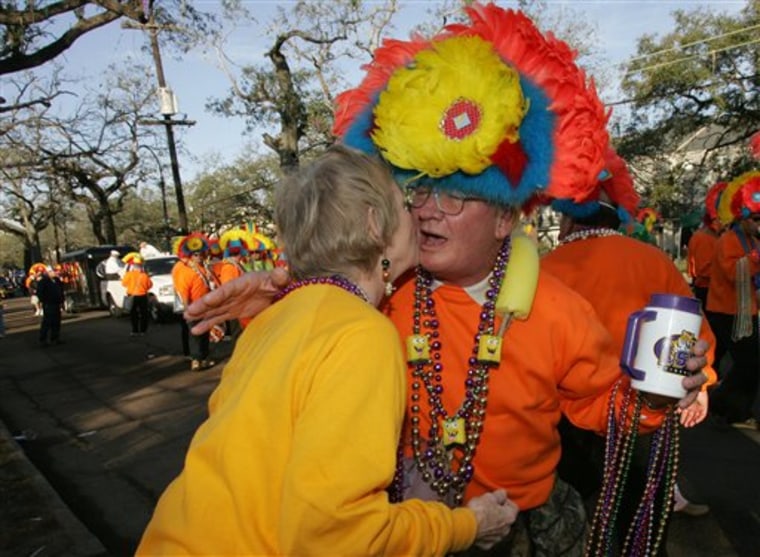Mardi Gras in New Orleans means more than the girls who go wild on balconies for beads.
Members of the Zulu Social Aid and Pleasure Club are hosting what they call a family-friendly party today that’s nothing compared to what awaits on Fat Tuesday.
The 90-year-old group is throwing the Lundi Gras Festival at the foot of Canal Street by the French Quarter. It’s a Mississippi riverfront affair with music, food and introduction of the Zulu king and queen and other parade characters. And there’ll be the traditional decorated coconuts, beads and trinkets handed out.
Members say the Zulu club wants to help the city recover from Hurricane Katrina.
Nothing ‘fake’ in Lower NinthA steady stream of cars winding their way past the twisted wreckage and beat-up vehicles of what was a lower-income, mostly black neighborhood shows the Lower Ninth Ward has become a tourist attraction itself, said resident Darrel Jackson.
“This ain’t fake. You see it -- this is as real as you’re going to get it,” he said.
The area is not far from the famous French Quarter that is the epicenter of Mardi Gras partying -- which culminates on Tuesday after a shortened schedule of parades and other events in the ailing city called “The Big Easy.”
Some in the ward see things differently. They believe the carnival is a good opportunity to give outsiders a first-hand look at a neighborhood still in a state of ruin and starved of electricity and other basic services.
“It brings awareness, not just that it looks like this, but about how it’s still looking like this after six months, and why that is,” said Jess Niederer, who works with aid group Common Ground Relief. Its makeshift office is in the worst-hit part of the ward, near the Industrial Canal levee.
“There’s a discrepancy between different areas and how quickly some places have come back,” said the 22-year-old student. The group welcomes tourists who have trickled over from Mardi Gras, answering their questions and passing out brochures.
T(-shirt) timeNew Orleans’ French Quarter may not have invented the crazy T-shirt -- but, over the years, it’s perfected it to an art form. Some are funny, some are profane and some are topical. This year, there are plenty of shirts bearing commentary about Hurricane Katrina.
One shirt says “Twisted Sister — Katrina and Rita” the two storms that pummeled Louisiana. Another plays off the Katrina and Rita theme — but calls them “Girls Gone Wild.”
There are shirts that criticize the Federal Emergency Management Agency too. One says, “FEMA — Federal Employees Missing Again.” Another reads “FEMA — the new four-letter word.”
The New Orleans Police Department is also derided for its performance during Katrina. There’s a shirt that reads “NOPD: Not Our Problem, Dude.”
A chance to forgetA prominent New Orleans restauranteur says Mardi Gras is critical to the city’s emotional recovery.
Clark Brennan, the general manager of the famous Brennan’s restaurant in the French Quarter, says Hurricane Katrina has damaged the spirit of the people. He says they need the solace that familiar traditions often provide. Brennan says “when these beautiful floats come down the street, you can forget your problems for a little bit and say throw me something, mister.”
Brennan says city and state officials have to do more to reassure displaced New Orleans residents that it’s OK to come back. That means putting essential services in order, so people can rebuild.
Brennan’s home and restaurant flooded following Katrina. He says he had to throw out more than $1 million of wine, brandy and cognac, some dating to the mid-1800’s.
New Orleans restaurants have reported brisk business, although less of it. More than two-thirds of the city’s 1,900 restaurants are still shut down.
Fountain sits one outBack in the 1950’s and 60’s, if you said “New Orleans Jazz” people would respond, “Pete Fountain.”

The legendary clarinetist grew up in New Orleans and still lives in the city. His home flooded following Hurricane Katrina, washing away a lifetime of photos, musical scores, instruments, and memories.
Though his Half Fast Marching club's march is a traditional Mardi Gras highlight, Fountain found himsels on the sidelines for first time in 46 years Tuesday morning. The 75-year-old musician was ill with high blood pressure, said his manager, Benny Harral.
Fountain says he was stunned by the fury of the storm and still has not recovered from the shock of the loss. He’s lost 25 pounds and has battled depression.
Fountain says he will never compose a piece called “Katrina.” In his words, “it’s a beautiful name but boy, she was mean.”
The jam continuesLocal residents said this year’s pre-Lenten celebration had brought people together in a special way after the shared tragedy of Katrina.
“It is slower, but better in quality,” said Inez Quintanilla, bartender at Lafitte’s Blacksmith Bar in the French Quarter. “Anyone who is here is here because they want to be.”
“Everyone is definitely feeling the love. It’s a real good vibe,” she said.
In previous years, a million people would cram into New Orleans for the climactic final weekend of Mardi Gras, but some officials estimated this year’s crowd at 400,000.
They said the turnout was not bad given that only about 190,000 people now live in the city that once had nearly half a million residents and that large parts of it still lie in ruins from Katrina’s floods.
Despite the reduced numbers, streets were jammed with cars, parking was at a premium and popular nightspots had long lines of people waiting to get in.
“Mardi Gras is usually hell, and this year is no different,” said New Orleans police officer R.M. Ruiz. “It’s a pretty big turnout, actually, a lot like before.”